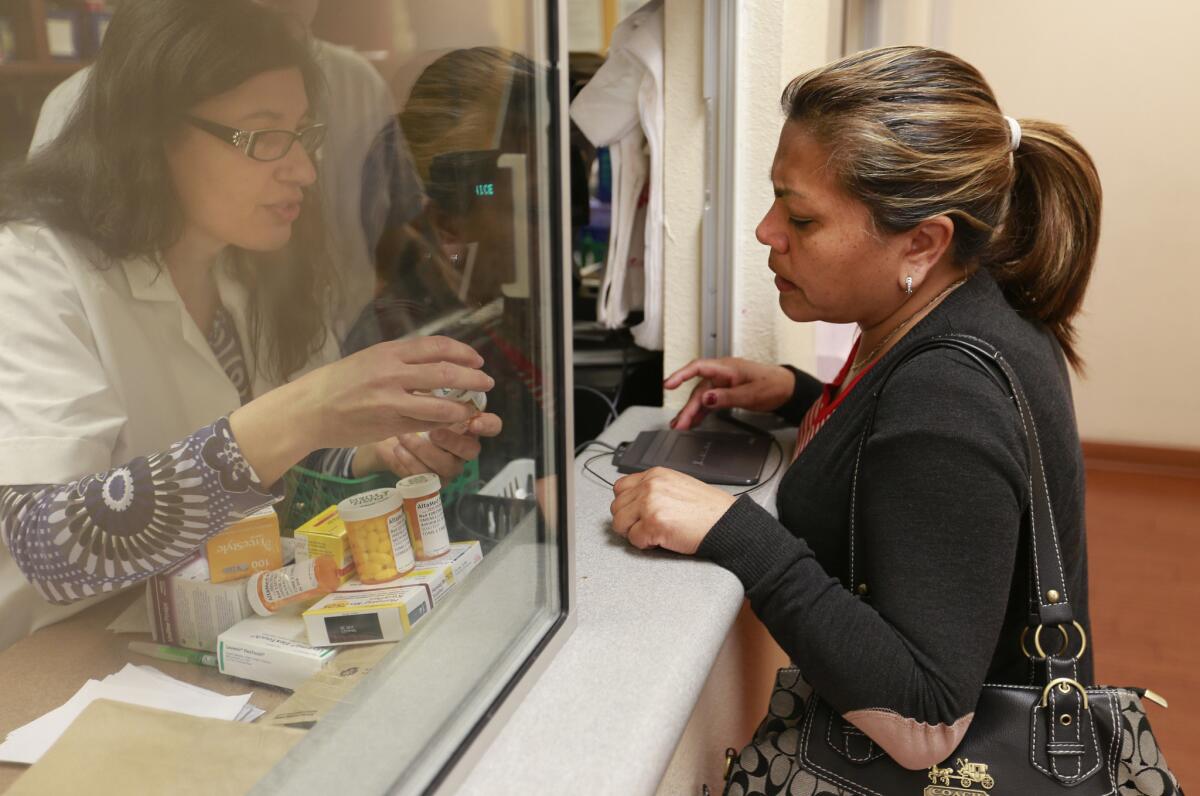Four largest states have sharp disparities in access to healthcare

Lucia Jimenez has her prescription filled by pharmacist Alaria Kiraz, left, at AltaMed clinic in East Los Angeles.
- Share via
WASHINGTON — The national divide over the Affordable Care Act is beginning to affect Americans’ access to medical care and perhaps even their ability to pay medical bills, a new study of the country’s four largest states suggests.
Residents of Florida and Texas, which have resisted expanding insurance coverage through the health law, reported more problems getting needed care than residents of California and New York, which both guarantee coverage to their residents.
Floridians and Texans were also significantly more likely to struggle with medical bills and to report that they had medical debt, according to the study from the Commonwealth Fund, a New York foundation that studies health systems domestically and around the world.
“Health policy decisions made by state leaders matter,” the study’s authors conclude, warning: “Coverage gaps are leaving millions uninsured and without access to affordable coverage.”
The new research adds to growing evidence that the 2010 health law may be widening geographic health disparities in the United States, an increase driven in large part by state decisions about whether to open their government Medicaid programs to poor adults.
Some states have expanded Medicaid with federal aid made available by the law; other states — all led by either Republican governors or legislatures, or both — have turned down the assistance, citing concerns about Medicaid’s effectiveness and cost.
National surveys have already shown that has dramatically affected rates of coverage.
States that fully implemented the law saw a 4.8 percentage-point improvement in the share of adults with insurance from 2013 to 2014, according to a recent Gallup poll. That was nearly twice the rate of states that have not fully implemented the law.
The increases in coverage also are improving access, other research indicates.
A study of billing data published last month by researchers at Quest Diagnostics found that the number of Medicaid patients with newly identified diabetes surged 23% from 2013 to 2014 in states that expanded their programs, while there was virtually no increase in states that declined to expand coverage.
Commonwealth Fund researchers looked at patients’ own descriptions of their healthcare experiences in a 2014 national survey that the fund conducted on health insurance coverage.
The problems in Texas and Florida, which have among the highest rates of uninsured in the country, were widespread.
More than 40% of residents of the two states reported that they did not go to the doctor when they were sick, didn’t fill a prescription, didn’t see a needed specialist or skipped a recommended test or treatment in the previous year.
The same proportion reported they had been unable to pay a medical bill, had been contacted by a collection agency over a medical bill, had had to change their way of life to pay bills or had medical debt.
By contrast, just 31% of Californians and 30% of New Yorkers reported the same access problems. Even fewer said they had the same struggles with medical bills.
Researchers noted that a variety of factors may help explain these differences.
Insurance policies in Florida and Texas tend to have higher cost-sharing requirements, for example, which probably feed consumers’ billing challenges in those states.
Insured Californians and New Yorkers were half as likely as insured Texans and Floridians to report having health plans with deductibles that were at least 5% of their income, according to another survey. People with higher deductibles are more likely to report not getting needed care.
But the large differences in insurance coverage between the states probably explains much of the disparities in access, said Sara Collins, a Commonwealth Fund vice president and one of the study’s authors.
Thirty percent of working-age Texans and 21% of working-age Floridians were uninsured in 2014, according to the study. By contrast, 17% of working-age Californians and 12% of working-age New Yorkers were without coverage last year.
“We know that increasing coverage improves people’s ability to get access to medical coverage,” Collins said.
More to Read
Inside the business of entertainment
The Wide Shot brings you news, analysis and insights on everything from streaming wars to production — and what it all means for the future.
You may occasionally receive promotional content from the Los Angeles Times.











